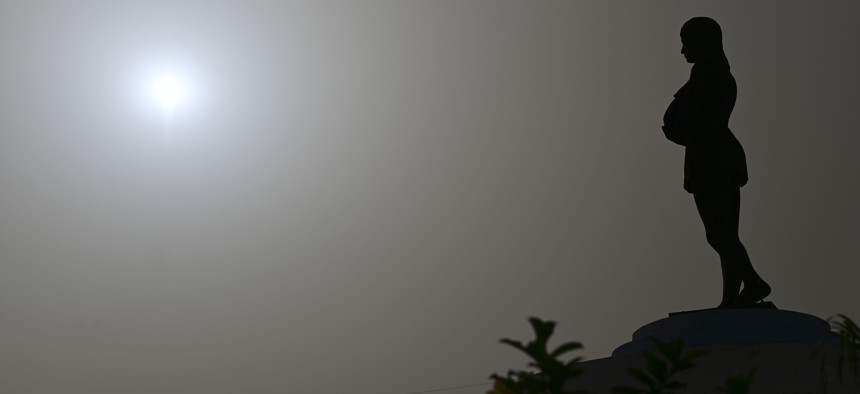Saharan Dust Sweeps Into Gulf Coast Region

A cloud of Sahara dust hangs in the air in Canovanas, Puerto Rico, Tuesday, June 23, 2020. AP Photo/Carlos Giusti
The atmospheric event isn’t uncommon, but this time the plume is unusually large. It could pose some health risks for people with preexisting respiratory conditions.
A giant plume of dust blown from the Sahara Desert in North Africa, thousands of miles across the Atlantic Ocean, is expected to fill the skies above parts of the Gulf Coast region of the United States during the coming days.
The Saharan Air Layer, as the mass of dry, dusty air is known, is a normal atmospheric occurrence this time of year. But experts say that the dust cloud that’s now beginning to appear in Gulf Coast states is especially large compared to past ones.
“What’s unusual about this event is that it is huge,” Joseph Prospero, a professor emeritus of atmospheric sciences at the University of Miami, said this week in an article published by the university.
“There’s been high concentrations of dust pouring off the west coast of North Africa for the past two weeks. And the concentrations in this outbreak are something I can’t ever recall seeing in all the decades I’ve been studying such phenomena,” he added.
The dust has already shrouded parts of the Caribbean, causing hazy skies and poor air quality.
"It’s the worst I’ve seen since we’ve kept records," Evan Thompson, director of the meteorological service division in Jamaica told Reuters. “We are seeing a much thicker mass of dust particles suspended. It is a lot more distinct and noticeable,” he added.
Images posted online on Thursday showed dust building in the sky around New Orleans.
New Orleans Health Department officials cautioned that the dust was expected to continue passing over Louisiana through Friday and said that the reduced air quality could raise health concerns for people with conditions like asthma, bronchitis and heart disease.
They also noted that the dust may pose heightened risks for people who are experiencing symptoms of Covid-19, the respiratory illness that has been afflicting the U.S.
Taking steps like avoiding outdoor activity, wearing face masks and staying in air-conditioned areas are precautions that can help, the city’s health department said.
The Texas Commission on Environmental Quality forecast that air quality could deteriorate to levels that are unhealthy for sensitive groups as the dust surges into the state heading into the weekend and spreads inland from the south.
Naresh Kumar, a professor of environmental health at the University of Miami, said that people with asthma and other respiratory conditions face the increased risks of flare-ups due to the dust and that foreign bacteria and inhalable particles could raise the odds for allergic reactions and infections in areas the plume affects.
The dust could have some upsides. The Saharan Air Layer has properties that can suppress the formation and intensification of hurricanes, according to Jason Dunion, a University of Miami hurricane researcher working with the National Oceanic and Atmospheric Administration.
Dust particles hanging in the air can also cause dramatically colored sunrises and sunsets.
Bill Lucia is a senior reporter for Route Fifty and is based in Olympia, Washington.
NEXT STORY: Rhode Island Moves to Remove ‘Plantations’ From Official State Name






